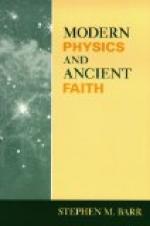“This gives us the line of 24-hour axial rotation, the true surface of the earth, and the sheer-line of prakritic matter. Beyond that line is the ether; within that line is prakriti.
“It is the line of no weight, where gravity and apergy exactly balance. Inside that line gravity exceeds apergy and everything revolving in less time, or that time, must fall to the centre. It is the true surface of any 24-hour globe of this size and weight. A moon to revolve around the earth in less than one day must move faster than the earth to develop enough apergy to overcome the attraction. That phenomenon we see in the moons of Mars, which are within its atmosphere; within the planet itself.
“We of the East learned this true size of the earth over six thousand years ago, from observing the moons of Jupiter. The times of the first three are doubled. We asked ourselves what this meant and found that their distance was increased by the cube root of 4 when their times were increased by the square root of 4; that time was to distance as 1.6 was to 2. Then we applied the key, and found it unlocked many mysteries.
“The first lesson this taught us was that we did not live on the earth, but within the earth, at the line of liquid and gaseous changes, where the three forms of matter meet and mingle and interchange with each other. We lived at the bottom of a gaseous ocean 21,000 miles above us, and 4,000 miles from the centre of the globe. It gave us an entirely new conception of the earth, and of our place in it.
“We saw that we lived in a narrow belt, or skin, of the earth, not more than 100 miles thick, perhaps not more than ten miles. Within this belt the prakritic elementary substances varied their condition, combined, and made forms by increasing or decreasing vibration. It was the creative and destructive zone, the evolutionary “mother”—the liquid level of the prakriti—the seat of all physical phenomena. Fifty miles above, the masses of nitrogen and oxygen and argon were too cold to change their rate of vibration. Fifty miles below the surface of the earth all things were too hot for changes in vibration. In this kinetic belt, between two static masses our bodies had been made, and also, in all probability, all combinations of the elementary substances. It was four thousand miles to the centre of the static prakritic mass beneath us; twenty-one thousand miles to the surface of the static prakritic mass above us, and the small kinetic belt between was only one hundred miles thick. But we had one consolation, the prakriti we had was all kinetic, and the best in the whole mass.
“The second lesson it taught us was that as the earth had been made in the etheric globe, in a corresponding skin or plane of kinetic etheric energy, with our ether the best of the solar output, that we ourselves were subject through our ether to the phenomena of that kinetic solar plane in precisely the same way we now are to the phenomena of the kinetic prakritic plane. Once rid of the fallacious notion that we were creatures of the surface of the earth, once clearly conscious that we were creatures of the interior, of the bottom of this gaseous ocean, then we could understand not only how the earth could be created in this etheric globe, but how we could be creatures of the solar globe living on it.




